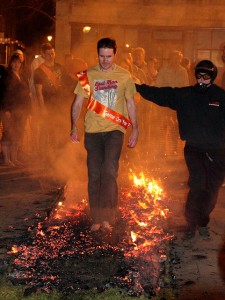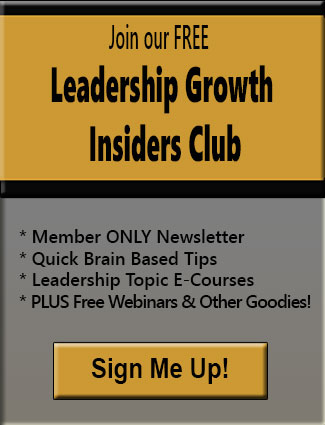Top Leaders Communicate Authority Through Body Language.
Do You?
Can your body language …
- Make a difference in commanding leadership authority?
- Create trust or mistrust within an organization?
- Change your emotions after a stressful day?
Absolutely!!
Leadership authority is a by-product of 2 related aspects of yourself – your physiology and your emotional state. Call them the yin and yang of leadership authority.
The purpose of this article is NOT to give you a list of gestures, postures or leadership do’s and don’ts to communicate authority. Your emotions and your body language are both driven by your mind. And your mind is too complex for such generalizations.
An effective gesture in one context may backfire in another context. A smile may uplift people in certain situations. A smile when someone is angry however may escalate more anger.
The goal of this article is to teach you how to use your body language for communicating leadership authority, building deep trust and even changing your emotional state. Your body language can enhance or destroy your business relationships and influence on others. Let’s look at why.
The Mind Body Leadership Connection
A physiology of confidence is different than a physiology of worry. Your emotions follow your physiology by responding to tension levels, breath rate, speed of movement and your focus. On the other end, scientists now know that different emotions have a clear physiological response shown through your body language.
For example, anger can be detected through such body signals as leaning forward, flushed face and invasion of someone else’s space. Fear often triggers a dry mouth, holding one’s breath, lack of eye contact and other “fight or flight” signals.
You can also intentionally alter your emotional state by altering your physiology. For example, taking a few deep breaths can transform anxiety and stress to relaxation and clarity in an instant.
Create your physiology of leadership.
Have you ever attended a Tony Robbins’ event? If you have, you know that Tony Robbins is Mr. Physiology himself.
He is a master at energizing thousands of people for long 18-20 hour days non-stop. He is a master at teaching participants – scared out of their minds — to walk over hot coals by putting “mind over matter.” His magic?
He builds into your neurology a new physiology to change your state of mind. All that dancing on the stage is for a reason. Pumping your fist in the air … yes, that’s intentional too. From my involvement in a number of his programs, I learned I can change my emotions in an instant by changing my physiology.
Want to feel more passion? Move more rapidly. Speak more rapidly. Model the physiology of the most passionate people you know.
Want to interrupt anxiety or fear? Look up at the sky, smile and say the made up mantra “cool moss.” The latter is just to distract your mind from thinking fear thoughts.
Want to show authority? Stand tall with feet shoulder width apart and weight equally balanced. Because authority is nonverbally communicated through height and space, the taller you appear and the more room you occupy, the more you look like you are in command. Remember also to own your space as addressed in Unleashing your Leadership Presence.
The work that Tony Robbins has been doing for decades is now backed by science.
According to researchers at Columbia and Harvard Universities, body language symbolizing power can actually affect leadership decision-making. Those who stood in power poses not only felt more powerful and in control. They were 45% more likely to take risks.
Purposefully expand your posture and you will alter your hormone levels – decreasing cortisol and increasing testosterone. A lower cortisol means lower stress. Higher testosterone means higher energy and an improved mood.
Takeaway: One small change in posture can trigger significant changes in how you feel and what you do.
Create instant trust and influence with your body language.
When you look at charismatic leaders, they have one skill in common – the ability to create deep rapport. Rapport is essential for any meaningful communications to take place — whether between a leader and a peer, between a boss and employee, between a leader and the entire organization.
Anything is possible in the presence of rapport.
Nothing is possible without it.
Dr. Milton Erickson
There is no leadership influence or trust without rapport. Have you ever had the experience of talking to someone and sensing disconnection when they did not respond? It’s uncomfortable not to have rapport with someone. Now you can change all that with rapport building skills, as outlined in this article.
First, however, we need to define what rapport IS and IS NOT. Let’s clarify the common myths about rapport.
Rapport IS …
- Deep unconscious connection with another that creates understanding and trust.
- Appreciating (not necessarily agreeing with) another’s perspective.
- Understanding and accepting another’s feelings.
- A form of influence
Rapport IS NOT about …
- Liking someone
- Small talk
- Similar interests
- Accepting what someone says or does.
The above means that you can have rapport with someone and not even like them. You can have rapport with someone while disagreeing with them. You can have rapport without needing to create small talk.
People in rapport experience a resonance with each other. They adopt the same posture, gestures, head tilt and rate of breathing. When one leans, the other leans too. All of this body language matching is happening below their conscious awareness.
Step 1: Set an intention of win/win.
The first step is to set an intention for a win/win outcome with someone you would like to build rapport. Because matching and mirroring physiology (or even written communications) is so powerful for building rapport, it should never be used for manipulative reasons.
Step 2: Match physiology.
Pick at lease one aspect of that person’s physiology you would like to match until you sense rapport.
Below are a few options.
- Smile
- Arms or legs crossed
- Siting back or forward
- Source of breath – chest, under the diaphragm or in the belly
- Rate of breath
- Eye contact
- Eye brows raised
- Tilting of head or body
- Sitting slouched or upright
By matching someone’s body language, you put yourself in sync with the other person’s behavior and meet them in their model of the world. It’s magical when it happens!
The secret to successful rapport building is to match and mirror outside the other person’s conscious awareness. When you match someone’s body language, you would not do so simultaneously with the other person. Instead, you would wait till it is your turn to speak and then use a similar gesture or aspect of posture. This way they become aware of your connection on an unconscious level.
Matching and mirroring is not just a physiological phenomenon. When you are in rapport, you activate the same thinking and feeling circuitry – called mirror neurons – in your brain as in the other person. You think similar thoughts. You feel similar feelings. Doing so creates an instant connection and trust.
Step 3: Test your rapport level.
After you have been matching and mirroring for 5 – 10 minutes, check to see if you have rapport with the other person.
To do so, stop matching and intentionally shift some aspect of your physiology — such as, crossing your legs or leaning back in your chair – and notice what happens.
Does the other person’s body language start to mimic yours?
If so, you are in rapport. Once you have successfully matched, you create an environment in which you can lead the other person where you want them to go.
For a leader, that’s power! The possibilities are endless how a leader can use rapport to influence an individual or an entire organization, such as …
- Getting emotional buy-in from employees for your company’s vision.
- Leading change within your organization without resistance.
- Creating alignment with your peers around a common decision
- Relaxing nervous job candidates during an interview
- Introducing a new way of doing things when a person or team has become fixed in their ways.
Takeaway: Matching and mirroring physiology is one of your most powerful, yet under-utilized, leadership tools for creating rapport and trust. And you can learn it in minutes.
Final comments
Your body language can make or break your leadership influence, emotional state and trust within relationships. While it’s easy to use your physiology to increase your leadership effectiveness, it does take focus, intention and practice.
Decide right now what situations in the coming week – a meeting, performance review, customer negotiation, etc – in which you will use your body language to communicate authority, build rapport or just feel good for no good reason.
Then email me and let me know the outcome.







